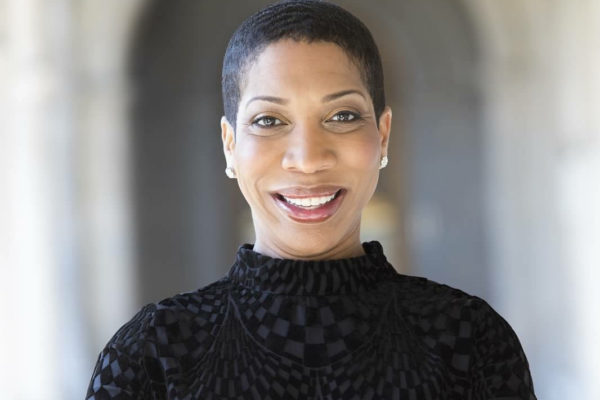It all started with Sanskrit.
About to go to Harvard as a physics major, Hillary Anger Elfenbein read a book that had been translated from Sanskrit — by someone humble enough to admit, in the introduction, that Sanskrit was essentially untranslatable.
She then wanted to read it in the original.
She added a major in Sanskrit, reasoning that a liberal arts degree had more to do with critical thinking than career prep. Her study of that language’s orderly universe left her fascinated by Indian culture, which eventually led her to volunteer with a women’s rights group in Calcutta and a health organization in Mumbai (then Bombay).
Which was great, except that in the early weeks, she kept feeling as if people were yelling at her.

“I was constantly convinced that certain colleagues were angry,” she says, “because I was misjudging the meaning of intensity.” Luckily, she was primed to notice. By the time she went to India, she had worked at Monitor Company, a management consulting firm. There, she’d noticed how much time and effort people put into decoding each other’s emotions. They scrutinized their boss’s facial expressions for feedback; they worked to detect sarcasm or subtext in their colleagues’ offhand comments; they tried, like kids playing jump rope, to figure out when it was their turn to speak. “The psychological dynamics in the workplace were much greater predictors of the success of a project,” Elfenbein says she realized, “than the quality of the analysis.”
For example, Elfenbein’s consulting firm once was assisting a company with divesting a business unit and creating decision-support tools to examine the impact of various scenarios. “It was stressful for the company that this business unit was failing,” Elfenbein says, “and the team leader spent a lot of time calming the client before the client could sit down to the tools we were painstakingly developing.”
Intrigued by the slipperiness of our emotional language, she returned to Harvard to study for a doctorate in organizational behavior. (She also earned a master’s degree in statistics and completed the course work for the MBA.) Now, as the John Wallace Jr. and Ellen Wallace Distinguished Professor at Olin Business School, Elfenbein studies the emotional currents and riptides of interpersonal communication. She’s shared her findings with Congress, high-powered executives and students.
Applications — and implications — crop up in every arena of human life. But Elfenbein has a single, overarching goal: fathoming the sense we make of other people’s feelings. When do we recognize them accurately? What subtle nuances do we miss? How, especially, do we decode emotion from facial expressions, tones of voice and body language?
Her students are fascinated by these questions — and grateful for the clarity and emotional support she offers as they explore. “As a mentor, she blends expert technical guidance with compassion and understanding,” says doctoral candidate Elizabeth Luckman. “This makes her not only a great teacher but also a good friend, always willing to take the time to help you wrestle with complex ideas.”
Elfenbein’s been wrestling herself with complex ideas for some time. She’s already published more than 60 scholarly articles spanning psychology, business and medicine. And her work has about 3,000 citations in the Web of Science, an online subscription-based scientific citation indexing service. She could coast for a bit. Instead, “she continues to strive to improve so that she can be influential and relevant,” Luckman says.
Elfenbein gathers some of her data in India and Kenya, because she’s acutely aware of how skewed our understandings are. Until recently, the existing research all had focused on what are called the WEIRD countries — Western, educated, industrialized, rich and democratic. We have no idea, yet, how much of what’s been learned is universal.
But her work is pointing out how often it’s not.
“She’s done some truly pathbreaking work in perception of emotions,” says William Bottom, the Joyce and Howard Wood Distinguished Professor of Organizational Behavior and chair of the organizational behavior program at Olin. “The ability to understand and perceive how people are reacting to decisions, information, policies, potential deals is really fundamental, and Hillary was able to demonstrate that we have distinct nonverbal ‘dialects.’ These dialects make it far easier for us to perceive and understand local emotions — but this is far more difficult communicating across cultures.” In a global economy, this work “is just incredibly important,” Bottom says. “And she’s extended it to look at how groups function, how deals are made, how negotiations break down.”
Even within the U.S., there are dramatic differences and misunderstandings. Other researchers had concluded that African-Americans with schizophrenia had greater emotional deficits than whites with schizophrenia, Elfenbein says. “But my work shows that it’s easier to recognize emotion from one’s own group.” When researchers built on that insight, they found no greater deficits among African-Americans. “They’d just been given a culturally biased test.”
Another kind of bias crops up with power differences: “Men and higher-status individuals are given more room to express anger and contempt,” she notes. “These are emotions of power; they say, ‘I am in a position to judge you.’ When women executives or political leaders express anger, they’re often critiqued. Women expressing anger are seen as irrational.” Sadness, by contrast, “is considered an emotion of low power, and women are allowed to be sad whereas men are derided. This myth that women are more emotional? Men are emotional, too, but there are different emotions they are free to express.”
Emotions have their place
Emotions we aren’t free to express tend to come back again and again. We bury them, and they bubble up somewhere else; we bat them away, and they boomerang. We can’t free ourselves from an emotion by suppressing it; we have to manage it. Reappraise, reframe, find the bright side, take the long view. “Talking to a friend is cathartic,” Elfenbein says, “and hopefully the friend is helping with reframing.”
Our bodies can help us, too — deep breathing, yoga, mindfulness, the endorphins of a good run, the indulgence of chocolate, the relaxation of a beer after work. “Every strategy that works for somebody can be taken too far,” she adds hastily. “But there’s a reason we call it ‘comfort food’ and have a drink at ‘happy hour.’ Those physiological methods give you a breather from the emotion, so you can regain perspective. It doesn’t seem so bad anymore. You have better resources to cope.”
When business executives turn to Elfenbein for help, they often ask how to manage anger and fear in the workplace “because both of these are thought of as very unproductive.” She’s not prepared to throw any negative emotion away, though: “Even the emotions we may not find pleasant have a function in our evolutionary history,” she says. “We have needed them.”
“Anger is about relationship repair: It shows us that there is something going wrong that needs to be addressed.”
Hillary Anger Elfenbein
The accepted view of emotion is that it’s an alarm system, “directing our attention to something important,” she says. “Anger is about relationship repair: It shows us that there is something going wrong that needs to be addressed. Fear shows us that we are in danger. All emotions have their place.” She grins wryly. “They are often out of place, but they have their place.”
At work, Elfenbein continues, the problem with our emotions is that we’re so often “squashed from doing something about them. Emotions are meant to move us. The word ‘emotion’ itself comes from the Latin root movere. But usually in the workplace, you can’t act on your emotions,” she says. The trick is to find a way around that prohibition — a way to act productively. Fear, for example, is about a lack of control, so take back a little control, she advises. If you’re scared of losing your job, polish your résumé.
Another workplace threat is jealous, malicious competitiveness — and it’s extra hard to recognize, because it’s one-sided, and those feeling it take pains to conceal the signs.
“Some nonverbals are leaky,” Elfenbein says. “Research has shown that we tend to be better at controlling facial expressions, next better at tone of voice. Yet it’s much harder to control body language, especially posture and hand movements. It’s not that you can’t control these things, but people put less energy into trying to control them. So those are good places to look for leakage.”
When somebody’s silently resentful or scheming against you, though, “the best place to look is third parties,” a trusted co-worker’s take. “And look at what people do, rather than just what they say to you,” Elfenbein says. “Then you can try to neutralize the jealousy, although that’s hard. Sometimes you can try to offer things of value to that person: Do something that will help them succeed; tell them about an opportunity; show that you are useful as an ally.”
Oh, and don’t feel bad if it took you a while to even realize that this person was vying with you. In one study, she found that “the people best at seeing hidden messages were the least liked.” They could read the negative emotions — anger and fear and sadness — beneath someone’s tone of voice. “We call them ‘eavesdroppers,’ because they had a window into other people that was unwelcome.”
Recognized or not, negative emotions clutter our workplaces. The most underrecognized emotion, Elfenbein says, is a positive one: flow, that blessed state when you’re working at your peak on something that has meaning for you, rather than counting the hours and accumulating grudges. “Job satisfaction and job dissatisfaction have different sources,” she points out. “Job satisfaction comes from flow and self-actualization. Job dissatisfaction comes from colleagues who weigh you down, a copier that always breaks — minor annoyances that are called hygiene factors.” Getting rid of those annoyances isn’t enough, though, because job satisfaction is not simply the absence of irritation. “Being satisfied is enjoying what you do, being good at it, having a sense of mastery and a sense of purpose,” Elfenbein says.
“Money is a very complicated reward.” … At work, often the best reward a boss can offer is “sincere recognition of a person’s humanity, sincere appreciation of the things done well.”
Hillary Anger Elfenbein
What satisfaction is not, necessarily, is raking in a lot of cash. “Money is a very complicated reward,” Elfenbein says. “It’s as much symbolic as it is about the money itself.” In one study, she asked graduating MBAs about their negotiations for a full-time job: What was the dollar value of everything they negotiated, and how did they feel coming out of the negotiation — as though they’d been treated fairly and built a healthy relationship? “A year later, we surveyed their job satisfaction,” she continues. “How they were treated predicted their job satisfaction; the dollar gain did not.” At work, often the best reward a boss can offer is “sincere recognition of a person’s humanity,” she says, “sincere appreciation of the things done well.”
Executives regularly ask her how to test for emotional intelligence — or train it into their employees. “It’s very hard to change emotional tendencies in adults,” she tells them frankly. “Consultants want to charge a lot of money to come in and train, but research suggests that it’s very hard to move that dial.” Currently, she’s exploring the behavioral genetics of emotional abilities, and, sure enough, the preliminary results suggest “that emotional intelligence is, to some degree, genetic.” Granted, emotional IQ is also learned — but early on.
“We train empathy; we even train children how to lie.” Elfenbein remembers explaining to her son, very carefully, the value in telling a “white lie” to show appreciation for, say, an unwanted birthday present. “We teach them the right time to lie and how to lie. Also, they spontaneously lie, and we catch them, and that trains them to lie better.”
What we don’t train very well, because we don’t or can’t give kids good feedback, is “self-awareness, emotion recognition, anything that is silent.” As for self-awareness, some of us are so clueless about our own feelings that we’re not even aware of our lack of self-awareness.
High-priced consultants can’t plumb those depths. “The bad news is that almost none of what they offer works,” Elfenbein says. “The good news is that the two things that do work are free: motivation and practice. Simply caring about these skills improves them.” In one study by another investigator, Group A was told that a test would predict their leadership abilities. Group B was told nothing about the test. “Guess who did better?” she asks, grinning at the obviousness. “The people who thought the test was important.”
Still, reading emotions is like reading Braille with callused fingertips. Sarcasm is an exaggeration that means its opposite, which can create a lot of misunderstanding across cultures. “We are a very sarcastic culture,” Elfenbein says, “and people from other cultures get tripped up by this.” So do people within the culture. How often have you hesitated, asking yourself, “Was that sarcastic?”
Another quality that can trip us up is a monotone voice, which we tend to automatically interpret in a negative way. “That’s partly why email is such a dangerous form of communication,” she explains. “It can read as a monotone, so it can seem negative.”
Hence, the emoji.
“My understanding is that the original emoticons were invented very quickly,” Elfenbein says, smiling. “We can’t get by without that expressive impulse.”
Jeannette Cooperman is a staff writer for St. Louis Magazine.



